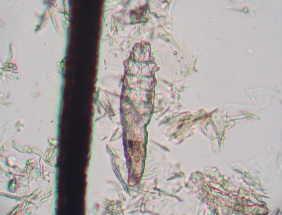SARCOPTIC AND DEMODEX MANGE
Sarcoptic Mange
A very common mange mite is a tiny, crablike creature that descends on dogs, burrows into their skin, and cause frenetic itching. Known medically as sarcoptic manage, the mite is invisible to the naked eye, and so the reaction it causes is often misdiagnosed as a severe allergic skin reaction. Even the recommended “skin scraping” method of diagnosis often fails to reveal this tiny mite.
Usually, sarcoptic manage is found on the ears and at the elbows, then spreads down the legs. Usually you see major scratching at skin that seems to grow more inflamed and itchy with every scratch. As it progresses, it emits a pungently foul odor. Cortisone – usually given to most dogs with symptoms of itching – will provide relief for dogs with mites at best a day (rather than weeks). Sometimes, Selsun shampoo can be surprisingly helpful – a prescription formula, not the milder, over-the-counter product Selsun Blue. If Selsun doesn’t work, some holistic veterinarians resort to medical treatment; a harsh dip, though toxic, is a onetime immersion that will eliminate the mites. Most will not use injectable ivermectin in treating this condition, as many conventional veterinarians will, because they feel that it is too toxic and immune-suppressive.
A satisfactory holistic remedy recommended is medical grade Lavender oil diluted 1:10 in almond oil along with a raw diet. Yellow dock tea is an alternative to the lavender. Use these daily for one to three weeks until you see improvement, then once a week for two or three more applications.
Usually, sarcoptic manage is found on the ears and at the elbows, then spreads down the legs. Usually you see major scratching at skin that seems to grow more inflamed and itchy with every scratch. As it progresses, it emits a pungently foul odor. Cortisone – usually given to most dogs with symptoms of itching – will provide relief for dogs with mites at best a day (rather than weeks). Sometimes, Selsun shampoo can be surprisingly helpful – a prescription formula, not the milder, over-the-counter product Selsun Blue. If Selsun doesn’t work, some holistic veterinarians resort to medical treatment; a harsh dip, though toxic, is a onetime immersion that will eliminate the mites. Most will not use injectable ivermectin in treating this condition, as many conventional veterinarians will, because they feel that it is too toxic and immune-suppressive.
A satisfactory holistic remedy recommended is medical grade Lavender oil diluted 1:10 in almond oil along with a raw diet. Yellow dock tea is an alternative to the lavender. Use these daily for one to three weeks until you see improvement, then once a week for two or three more applications.
Demodex Mange
Demodectic mange is more difficult to treat than sarcoptic mange. Demodectic mites are considered a normal inhabitant of dogs’ skin. They remain benign until an immune deficiency allows them to proliferate. The “localized” variation usually involves several small patches of hair loss, usually around the head area of puppies; the patches become a little scaly, though generally not itchy. They tend to heal spontaneously as the animal matures, though treatment can be hastened with medical grade tea tree oil; just apply the oil on the lesions. Use in very dilute dose –tea tree oil is very strong and can also cause reactions. Never use over the counter tea tree oil, as those are simply perfumes with synthetic ingredients in it. We only use Young Living essential oils at Gentry Boxers.
The other variation of demodectic mange, again due to an immune deficiency, is “generalized”, which means that it involves any part of the body, and sometimes the whole body. This is one of the most difficult problems to cure in veterinary medicine. The medical treatments are very toxic; with one, Scotts dip (named after its creator) no more than one-third of the dog can be dipped at a time or the dog could potentially perish due to toxicity of the dip. A dip called Mitaban is also pretty toxic. It kills the mites but fails to address the immune deficiency that allowed the mites to take hold in the first place, and thus may not prevent their return.
Many holistic veterinarians treat demodectic mange by putting the dog on a species specific raw diet, along with two herbal supplements, Viola 12 and Astragalus 10 Plus, both from Seven Forests. Sometimes tea tree oil amelioratse mange spots. Just do not purchase over the counter Tea Tree oil, as they are perfumes, not medicine. They can do more harm than good. We only use Young Living Tea Tree Oil on our dogs and ourselves. You could consider supplements containing thymus extract, to add immune support. Some veterinarians have had tremendous success using the IAH program – Dr. Lawrence Burton’s Immuno-Augmentative Therapy. (Although he used his therapy almost exclusively for cancer patients, Dr. Burton designed a protocol to treat mange from his own personal research on AIDS.) In some cases, after giving a lot of support and still seeing symptoms, vets recommend a Mitaban dip as a last resort to help kill those mites that have already proliferated.
The primary concern is to support the immune system, and a proper species-specific diet is the foundation for a healthy immune system. Vitamins, echinacea, cat's claw, and astragalus are good immune-system building herbs. For dogs up to 25 pounds, give one-fourth the human dose, for 25-50 pound dogs, give half the human dose; for larger dogs give the human dose. Use the herbs in alteration, two to three weeks at a time for maximum effect. Use yellow dock, calendula or echinacea tea as a topiclal rinse as needed. For our dogs, we use this set of supplements for immune system support. It includes pre and probiotics specifically for dogs, mushrooms that support the immune system, micronutrients often missing from even the best raw feeding diet, and essential fatty acids. If you are feeding kibble, choose the option for kibble fed kit, as it also contains the enzymes that are found in raw meat, but not in kibble.
Demodex cases take time - weeks to months. As long as it doesn't get worse and her energy and attitude are good, just keep up the fresh raw diet, supplements and herbs. You can try the following homeopathic remedies as well - Silicea, Sulphur or Psorinum. You can try them one at a time or muscle test to see which one would be best. If you cannot decide, start with Silicea, then try either Sulphur or Psorinum. If you have no success, call a homeopathic veterinarian.
The goal is always to allow the dog to heal herself from within.
The other variation of demodectic mange, again due to an immune deficiency, is “generalized”, which means that it involves any part of the body, and sometimes the whole body. This is one of the most difficult problems to cure in veterinary medicine. The medical treatments are very toxic; with one, Scotts dip (named after its creator) no more than one-third of the dog can be dipped at a time or the dog could potentially perish due to toxicity of the dip. A dip called Mitaban is also pretty toxic. It kills the mites but fails to address the immune deficiency that allowed the mites to take hold in the first place, and thus may not prevent their return.
Many holistic veterinarians treat demodectic mange by putting the dog on a species specific raw diet, along with two herbal supplements, Viola 12 and Astragalus 10 Plus, both from Seven Forests. Sometimes tea tree oil amelioratse mange spots. Just do not purchase over the counter Tea Tree oil, as they are perfumes, not medicine. They can do more harm than good. We only use Young Living Tea Tree Oil on our dogs and ourselves. You could consider supplements containing thymus extract, to add immune support. Some veterinarians have had tremendous success using the IAH program – Dr. Lawrence Burton’s Immuno-Augmentative Therapy. (Although he used his therapy almost exclusively for cancer patients, Dr. Burton designed a protocol to treat mange from his own personal research on AIDS.) In some cases, after giving a lot of support and still seeing symptoms, vets recommend a Mitaban dip as a last resort to help kill those mites that have already proliferated.
The primary concern is to support the immune system, and a proper species-specific diet is the foundation for a healthy immune system. Vitamins, echinacea, cat's claw, and astragalus are good immune-system building herbs. For dogs up to 25 pounds, give one-fourth the human dose, for 25-50 pound dogs, give half the human dose; for larger dogs give the human dose. Use the herbs in alteration, two to three weeks at a time for maximum effect. Use yellow dock, calendula or echinacea tea as a topiclal rinse as needed. For our dogs, we use this set of supplements for immune system support. It includes pre and probiotics specifically for dogs, mushrooms that support the immune system, micronutrients often missing from even the best raw feeding diet, and essential fatty acids. If you are feeding kibble, choose the option for kibble fed kit, as it also contains the enzymes that are found in raw meat, but not in kibble.
Demodex cases take time - weeks to months. As long as it doesn't get worse and her energy and attitude are good, just keep up the fresh raw diet, supplements and herbs. You can try the following homeopathic remedies as well - Silicea, Sulphur or Psorinum. You can try them one at a time or muscle test to see which one would be best. If you cannot decide, start with Silicea, then try either Sulphur or Psorinum. If you have no success, call a homeopathic veterinarian.
The goal is always to allow the dog to heal herself from within.
Testimonial from a seasoned boxer rescuer, Hope Bogner:
The late Marina Zacharius/Naturalrearing.com had an awesome Demodex protocol that Hope Bogner used with countless rescues through the years. She agrees that most will clear with just a quality diet without grain while supporting the immune system, but some rescues they worked on were terribly generalized. They never once had to use Mitaban or Ivermectin. It is 10 parts almond oil, 2 parts theraputic grade lavender oil (make up a bigger batch to have for daily application to skin) for Demodex, and then fresh squeezed lemon juice alternated during the day on affected areas (if really raw areas, dilute the lemon juice 50/50). In addition to the Lavender/Almond Oil blend and fresh lemon juice for the skin, in food give 23 mg Zinc BID (that is the size it normally comes in), 100 mg B-complex, 400 IU natural Vit E, 500 mg Vit C BID (can work up to 1,000 mg BID if tougher cases, but watch bowel tolerance), a quality multi-strain probiotic specific to dogs, digestive enzymes,1000 mg Omega 3 per 20# body weight (divide doses in each meal). If more generalized Demodex, Standard Process Canine Immune Support for extra whole body immune support and a Chinese herb called Viola. Naturalrearing.com has the Viola. The rest you can get using the hot links in this article from The Dog Breeder Store, and some things at a local health food store. The Standard Process is available through practitioners, so try getting it from a holistic vet or some chiropractors will order it for you. The raw diet makes an amazing difference and any supplements for the skin.



